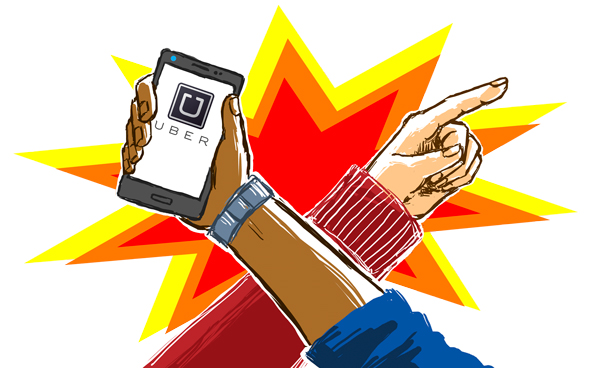Can these two services peacefully coexist, or is one inevitably going to usurp the other?
Illustration: Reine Tejares
Sept. 16 marked an international day of protest against Uber. Rallies were held in cities ranging from Brussels to Brisbane to Ottawa, where cab drivers expressed their displeasure with the continued operation of the ride-sharing company.
“We are here to just protect our business, because I’ve been driving a cab for 20-25 years and I’ve never seen this kind of illegal cab before,” said Sam Roukoz, a local cab driver who protested outside of city hall on Sept. 16 with his fellow cab drivers, explaining that their business is down approximately 25 per cent since last year.
“Now we have to work seven days just to cover the last of that 20-25 per cent. That’s why we are here now. It’s too much. We can’t do that anymore.”
Relations between Ottawa taxi drivers and Uber drivers have been tense since the arrival of the ride-sharing company in the nation’s capital in October of 2014. Animosity between the two parties reached new heights this summer, when airport cab drivers went on strike to protest plans to raise their pick-up fees to five dollars.
Although the cab drivers hold their dispatcher Coventry Connections responsible for this fee increase, they also blame Uber for putting them in a tough financial spot in the first place.
Heated confrontations between Ottawa cab and Uber drivers—including a recent incident where a Blueline driver uttered a death threat to an Uber driver near the Château Laurier—are adding fuel to the fire.
However, the battle between Uber and Ottawa cab drivers is far from over and, in order for a victor to emerge, at least one party has to be willing to compromise.
Tale of the tape
When looked at from afar both services perform the same basic function: they get you from point A to point B.
However, as soon as you dive into the logistics of it all, you come to understand that they’re extremely different in practice.
Despite being contested by cab companies worldwide, the Uber ride-sharing app has been incredibly successful since its inception in 2009.
In cities like Los Angeles, New York, Toronto, and now Ottawa, Uber has shaken the taxi industry to its core, mainly because it offers customers the same amenities as a traditional taxi service but with the added benefits that come along with being a cutting-edge software company.
Gilles LeVasseur, a lawyer and professor of law in economics at the Telfer School of Management, said that nobody thought a company like Uber “would impact so greatly and rapidly the stability of the (taxi cab) industry.”
But it did. Today Uber is worth over $50 billion, and is becoming a trendy transportation alternative for millennials and tech savvy adults alike.
Not only has Uber charmed the public with its cheap and convenient service, but it has also made it extremely easy for some to rake in a second source of income.
University of Ottawa alumnus Alex* has been a part-time Uber driver for almost a month now, and walked us through the process that landed him a job.
“You sign up and you send in some documents, like your driver’s license, proof that you can work in Canada, and then they do a background check to make sure you don’t have any criminal affiliations and all that.”
Alex went on to explain that the whole process takes about five business days, which gives Uber enough time to make sure the driver’s car is no older than ten years and has been inspected by a mechanic.
Once he was hired, Alex, like all Uber drivers, began to pick up customers via the company’s smartphone app. All the information a driver would need regarding transactions and dispatching can be found through the app as well.
Taxi drivers, on the other hand, go through a more complicated and costly process to acquire and maintain their job.
They are required to complete an intensive training course in order to get their taxi license. Their cars must also be inspected, and they can’t be more than eight years old.
A taxi driver is also required to have a taxi plate, expensive insurance, and must comply with city bylaws.
That last part is a major sticking point for Uber critics, who argue that the ride-sharing service is not subjected to these same rules.
“All these regulations, it’s all from the city, from the council. It’s not from us,” said Roukoz. “They put all these rules on us, for cameras, for metres, for the age of the car, for insurance, and now with Uber taxi and the illegal taxis we don’t see any (bylaws) over there.”
Needless to say, the two services operate under noticeably different business models.
Taxis are under the thumb of larger transportation companies, and the also must comply with city bylaws, and aren’t equipped with modern technological features. Uber, on the other hand, has simple-to-use technological features that make it more accessible.
While Uber seems to have won the public’s support right now, it’s hard to ignore the giant Sword of Damocles that threatens to stop its drivers cold: the law.
Legal grey area
All practicality aside, the legality of Uber is largely what sparked initial protests on behalf of taxi companies throughout the world.
Furthermore, the fluctuating legal status of Uber throughout the country demonstrates that there is no universal solution to solve the Uber-Taxi conflict.
While cities like Ottawa, Vancouver, and Calgary have deemed Uber’s operations illegal, Edmonton is considering legalizing the service on the condition that drivers earn a special license and are covered by commercial insurance.
Essentially, they want Uber to be a traditional cab service, which is something the company doesn’t want to do. Not being defined as a traditional taxi company affords Uber the legal wiggle room necessary to get a leg up on the competition in Ottawa, explains LeVasseur.
“Since the courts in Ontario have declared that this is not technically a ‘regular taxi’ activity, what needs does the City have to regulate Uber and enforce what is presently there?” he said.
Indeed, this legal ambiguity allows Uber to operate without requiring taxi licenses, plates, or extensive insurance from its drivers, which essentially explains why Uber fares are significantly lower than the average rate. They have no external costs for which they need to compensate.
This, according to local taxi drivers, is what is so unfair about this whole situation; that a company that is sharing the same industry and the same clientele is not subjected to the same laws because it follows a different business model.
“If they follow the same bylaws I follow, if they put a camera in their cars, they get a taxi license, if they have a taxi plate, if they have insurance, if they have all the safety features, sure,” said Amrik Singh, president of Ottawa’s taxi union, Unifor Local 1688. “We’re not afraid of competition, but the competition has to be fair.”
Of course, none of this has any real bearing on the consumer, who, in the end, is the deciding factor in which service comes out on top.
The customer is always right
When it comes to public transportation, people almost always go for the cheaper and more effective service, which is what has given Uber the upper hand so far.
After talking to a number of students on the U of O campus, all of them sympathized with the plight of local taxi drivers, but guiltily admitted that they would continue to use Uber.
“It’s cheaper. I’m a student. That’s what I’m looking for, right?” explained third-year psychology student, Kaitlin Hare.
Customers are also very fond of Uber’s easy and effective app. People like its fluid use, and they know that the service is reliable and convenient since the integrated GPS function allows you to locate nearby rides almost instantaneously.
Cab companies, for the most part, don’t equip their drivers with the same kind of phone applications or online services. It’s not clear whether this is caused by institutionalized corruption or apathy that’s symptomatic of many aging industries, but this rejection of all things new and modern is definitely their biggest hindrance in this fight.
However, the cab drivers themselves shouldn’t be blamed for their service’s lack of technological panache.
When asked about whether or not taxis should be equipped with some of Uber’s features (driver ratings, dispatch information, phone apps, etc.), Singh agrees with the idea wholeheartedly.
“If there’s anything that needs to be changed it is technology… and that’s the duty of the taxi company. It is their duty to make sure the dispatch is up to 20th century,” he said.
Convenience over safety
Most of the cab drivers we talked to also contested that the customers’ safety is another big concern.
Many taxi drivers, including Roukoz, believe that Uber puts the life of its customers in harms way because of its lack of licensing and insurance.
Some Uber riders would argue that they don’t feel more or less safe in an Uber because of the company’s rating system, which allows bad drivers to be weeded out in a public forum.
In reality, both services have had shady incidents reported in the news and whether you’re taking a taxi or an Uber, you’re still entrusting your safety to a complete stranger.
While LeVasseur admits that Uber has the upper hand in the customer satisfaction department right now, this might change somewhere down the line when the novelty of the service starts to wear off.
“Until there is, sadly to say, a tragedy that occurs, people will still take that risk. Because they see it as a short term opportunity. But then when they’ll be a crisis, for example, a major accident and you’ve got to ask yourself: ‘what is the coverage? What are the obligations of the driver’?”
Uber is so new a service and its organization is so shrouded in secrecy, that the answer to these questions are largely left without a clear answer.
Can’t we all just get along
While people on both sides of the issue have plenty to disagree about, they can at least be united on one idea—if Uber and taxi companies are ever going to coexist together, some things will have to change.
Both the Uber and taxi drivers we talked to agree that their companies and services could operate peacefully. However, both have a different way of explaining the details of this coexistence.
“They can exist. If they have the same regulations, if they have the same insurance, (the) same plates. Why not? We don’t mind. But you have to be fair,” said Roukoz.
However, Uber drivers such as Alex believe this current competitive dynamic is working and will eventually breed better a service overall.
“I think (Uber) is the best thing for the consumer. Because it gives them a little variety and it puts some competition into the industry, which tends to drive down prices and increase the quality of the product.”
This doesn’t mean that adaptation is impossible. But given the fact that the public’s appetite for convenient service and peace of mind is insatiable, both sides are probably going to have to have to make some concessions in the future.
For this conflict to end, either taxi companies will have to adopt technology that will make their business more accessible, simple, and appealing, or Uber will have to drop the “renegade taxi” act altogether and play by the rules.
In the meantime, maybe you should take the bus and avoid this civic blood feud altogether.
*Alex’s last name is being withheld to protect his identity.





